Mount Morris Park Historic District is a 16-block historic district in west central Harlem, Manhattan, New York City. It was designated by the New York City Landmarks Preservation Commission in 1971, and is part of the larger Mount Morris Park neighborhood. The boundaries are West 118th and West 124th Streets, Fifth Avenue, and Adam Clayton Powell Jr. Boulevard.
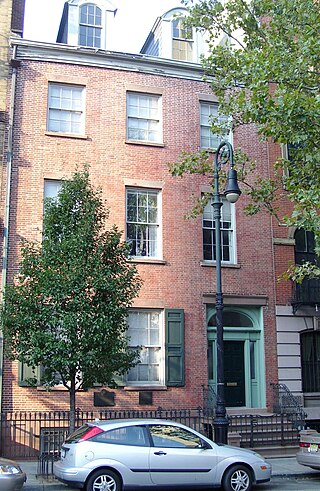
The Hamilton Fish House, also known as the Stuyvesant Fish House and Nicholas and Elizabeth Stuyvesant Fish House, is where Hamilton Fish (1808–93), later Governor and Senator of New York, was born and resided from 1808 to 1838. It is at 21 Stuyvesant Street, a diagonal street within the Manhattan street grid, between 9th and 10th Streets in the East Village neighborhood of New York City. It is owned by Cooper Union and used as a residence for the college's president.

The Ashton Historic District is a historic district in Cumberland, Rhode Island. The district consists of a mill and an adjacent mill village that was built for the workers of the mill. It lies between Mendon Road, Scott Road, Angell Road, Store Hill Road, Front Street and Middle Street. The district was added to the National Register of Historic Places on November 1, 1984.

Quinebaug Mill–Quebec Square Historic District is a historic district roughly bounded by the Quinebaug River, Quebec Square, and Elm and S. Main Streets in the town of Brooklyn in Windham County, Connecticut. The district encompasses a well-preserved 19th-century mill village. It was added to the National Register of Historic Places in 1985.
Athens is a small unincorporated village in Fayette County to the east of Interstate 75 in Kentucky in the United States.
The Broadway Historic District in Bangor, Maine, United States, bounded by Garland, Essex, State, Park, and Center Streets, is one of the residential neighborhoods most favored by the city's lumber barons and business elites in the early to late 19th century. A second and slightly later Bangor neighborhood of primarily elite houses, centered on West Broadway, is also listed on the National Register of Historic Places as the Whitney Park Historic District. Both historic districts are also protected under local ordinance.

The Central Troy Historic District is an irregularly shaped, 96-acre (39 ha) area of downtown Troy, New York, United States. It has been described as "one of the most perfectly preserved 19th-century downtowns in the [country]" with nearly 700 properties in a variety of architectural styles from the early 19th to mid-20th centuries. These include most of Russell Sage College, one of two privately owned urban parks in New York, and two National Historic Landmarks. Visitors ranging from the Duke de la Rochefoucauld to Philip Johnson have praised aspects of it. Martin Scorsese used parts of downtown Troy as a stand-in for 19th-century Manhattan in The Age of Innocence.

Birge-Horton House is a historic home located at Buffalo in Erie County, New York. It was designed in 1895 by the Buffalo architectural firm of Green and Wicks and is a Georgian Revival style row house in "The Midway" section of Delaware Avenue. It is a four-story brick house with stone trim. The house is situated within the boundaries of the Allentown Historic District.
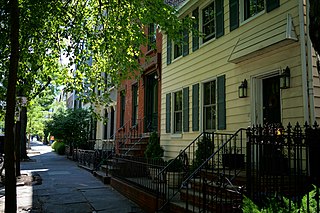
Wallabout is a neighborhood in the New York City borough of Brooklyn that dates back to the 17th century. It is one of the oldest areas of Brooklyn, in the area that was once Wallabout Bay but has largely been filled in and is now the Brooklyn Navy Yard.

There are 75 properties listed on the National Register of Historic Places in Albany, New York, United States. Six are additionally designated as National Historic Landmarks (NHLs), the most of any city in the state after New York City. Another 14 are historic districts, for which 20 of the listings are also contributing properties. Two properties, both buildings, that had been listed in the past but have since been demolished have been delisted; one building that is also no longer extant remains listed.
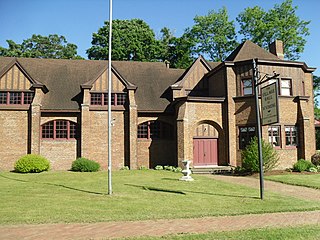
Wyoming Village Historic District is a national historic district located at the Village of Wyoming in Wyoming County, New York. The district covers about 45 acres (180,000 m2) and is organized as a New England village around a small triangular village green. The T-shaped district includes approximately 72 historic registered structures along two principal streets, Main and Academy Streets.

The Amherst Village Historic District encompasses the historic village center of Amherst, New Hampshire. Centered on the town's common, which was established about 1755, Amherst Village is one of the best examples of a late-18th to early-19th century New England village center. It is roughly bounded on the north by Foundry Street and on the south by Amherst Street, although it extends along some roads beyond both. The western boundary is roughly Davis Lane, the eastern is Mack Hill Road, Old Manchester Road, and Court House Road. The district includes the Congregational Church, built c. 1771-74, and is predominantly residential, with a large number of Georgian, Federal, and Greek Revival houses. Other notable non-residential buildings include the Farmer's Bank, a Federal-style brick building built in 1806, and the Amherst Brick School, a brick Greek Revival structure that has served as the School Administrative Unit 39 offices since 1997.

The Old Brick Church is a historic church building off Vermont Route 35 in Athens, Vermont. Built in 1817, it is a modest Federal style brick structure that served as a church and civic center into the 20th century. Architecturally it represents a transitional period, built with the furnishings of a typical 18th-century New England colonial meeting house, arranged on the long axis as was typical of 19th-century churches. It is now owned by the town, and was listed on the National Register of Historic Places in 1979.

Athens Lower Village Historic District is a national historic district located at Athens in Greene County, New York. The district contains 267 contributing buildings, including the Jan Van Loon House built in 1706. It includes residential, commercial, and ecclesiastical structures built primarily during the 19th century in a variety of popular architectural styles.

Essex Village Historic District is a national historic district located at Essex in Essex County, New York. The district contains 150 contributing buildings. It encompasses the historic core of the hamlet of Essex and primarily contains early-19th-century buildings. The predominant building materials are clapboarded wood frame, brick, and stone and none of the buildings exceed 2+1⁄2 stories in height. The oldest documented structure is Dower House, built prior to 1793. Other notable buildings include Wright's Inn (1798), Essex Free Library (1818), and "Hickory Hill" (1822), "Rosslyn", the "Old Brick Schoolhouse" (1830), and "Greystone" (1853).

68th Avenue–64th Place Historic District is a national historic district in Ridgewood, Queens, New York. It includes 46 contributing buildings built between 1909 and 1913. They consist mainly of two story brick row houses with one apartment per floor. Buildings feature alternating yellow, amber, brown and burnt orange speckled brick and cast stone detailing in the Romanesque Revival style.

The Madison–Putnam–60th Place Historic District is a national historic district in Ridgewood, Queens, New York. It includes 145 contributing buildings built between 1900 and 1920. They consist mainly of brick two story row houses with one apartment per floor and three story tenements with two apartments per floor. They feature brick facades and Romanesque Revival style detailing. Also included in the district is the Old Queens Labor Lyceum.
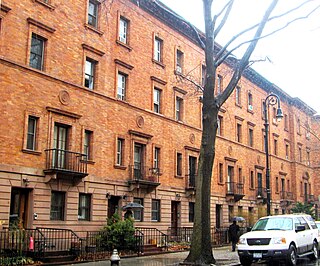
The St. Nicholas Historic District, known colloquially as "Striver's Row", is a historic district located on both sides of West 138th and West 139th Streets between Adam Clayton Powell Jr. Boulevard and Frederick Douglass Boulevard, in the Harlem neighborhood of Upper Manhattan, New York City. It is both a national and a New York City historic district, and consists of row houses and associated buildings designed by three architectural firms and built in 1891–93 by developer David H. King Jr. These are collectively recognized as gems of New York City architecture, and "an outstanding example of late 19th-century urban design":
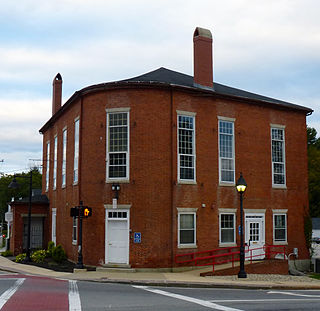
The Durham Historic District encompasses a portion of the original historic settlement area of Durham, New Hampshire. It extends along Newmarket Road from its northern junction with Laurel Lane to a three-way junction with Main Street and Dover Road. From there it extends along Main Street to Madbury Road. This area, known in early colonial days as the Oyster River Plantation, for the Oyster River which bisects it, was first settled in 1649. It was developed in the 18th century as a significant shipbuilding center. The district was listed on the National Register of Historic Places in 1980.

The Chester Village Historic District encompasses the historic southern portion of the main village of Chester, Vermont, US. Essentially a linear stretch of Main Street, this area includes some of the village's oldest buildings and has an architectural history spanning into the early 20th century. The district was listed on the National Register of Historic Places in 1985.






















